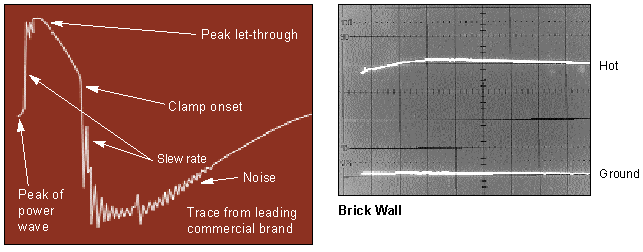New Performance Standards
The following graphic represents a comparison of standard
oscilloscope traces. The MOV based protector (left) and a Brick Wall Surge
Filter (right) are both experiencing a 1200V, 450A surge.

INSTANTANEOUS RESPONSE TIME
The heart of our units is the inductor. This is a passive component that
is in series. It does not
have to 'turn- on' and it represents the only path the surge current can
take to get to the load. It
reacts instantaneously. Almost all other surge protection devices are in
parallel. After a certain
voltage threshold is reached the shunt elements create a short circuit
diverting the surge current
away from the load. In effect it is a switching device. Any switch, no
matter how good, is going to
take time to go from an opened to a closed position.
CLAMPING LEVEL 2 VOLTS ABOVE THE SINEWAVE PEAK
MOVís are preset to clamp at certain voltage thresholds (usually around
220V). The
manufacturers walk a fine line here because too low a level and the MOV
turns on more and
wears out sooner. Too high a level and more unwanted current has access to
the load. Even
more importantly, marketing rhetoric is sacrificed. Our Series Mode device
has active tracking; a
180Ķf electrolytic capacitor constantly tracks the sinewave peak,
whatever the powerline voltage.
Any rise above this reference level is immediately clamped to this level.
LET THROUGH VOLTAGE <300V
Voltage that gets by a surge suppression device to the load is called the
let through voltage. The
lower the let through voltage the better. The above oscilloscope trace of
a Brick Wall product
shows a let-through voltage of 192V for a 1200V transient. That represents
an additional 20V
above the sinewave peak (the sinewave peak is normally 172V). UL endurance
tested the
product with one thousand 6000V surges and the let through never exceeded
290V (290V is the
approximate let through voltage an MOV-based device would experience at
1200V). We believe
this represents the lowest let through voltage in the industry.
SLEW RATE
Slew Rate is the rate of change of voltage in volts per microsecond. The
faster the slew rate the
more readily the overvoltage will couple to nearby datalines. Notice the
ascending slew rates of
the photographed oscilloscope traces. This is representative of the
voltage that 'hits' the load
before clamping. A quick rise such as this can represent quite a 'jolt' to
the equipment. The trace
of our unit shows a negligible slew rate. Again, we believe this
represents a new industry
standard.